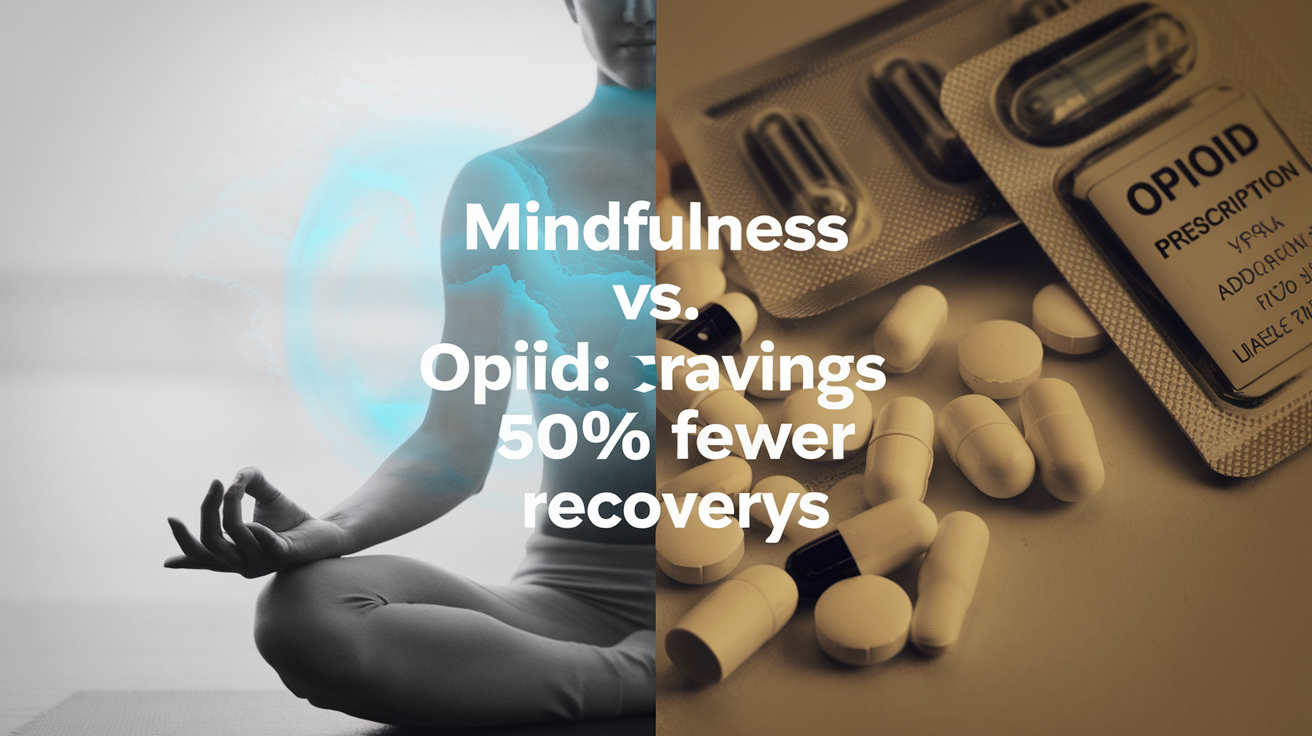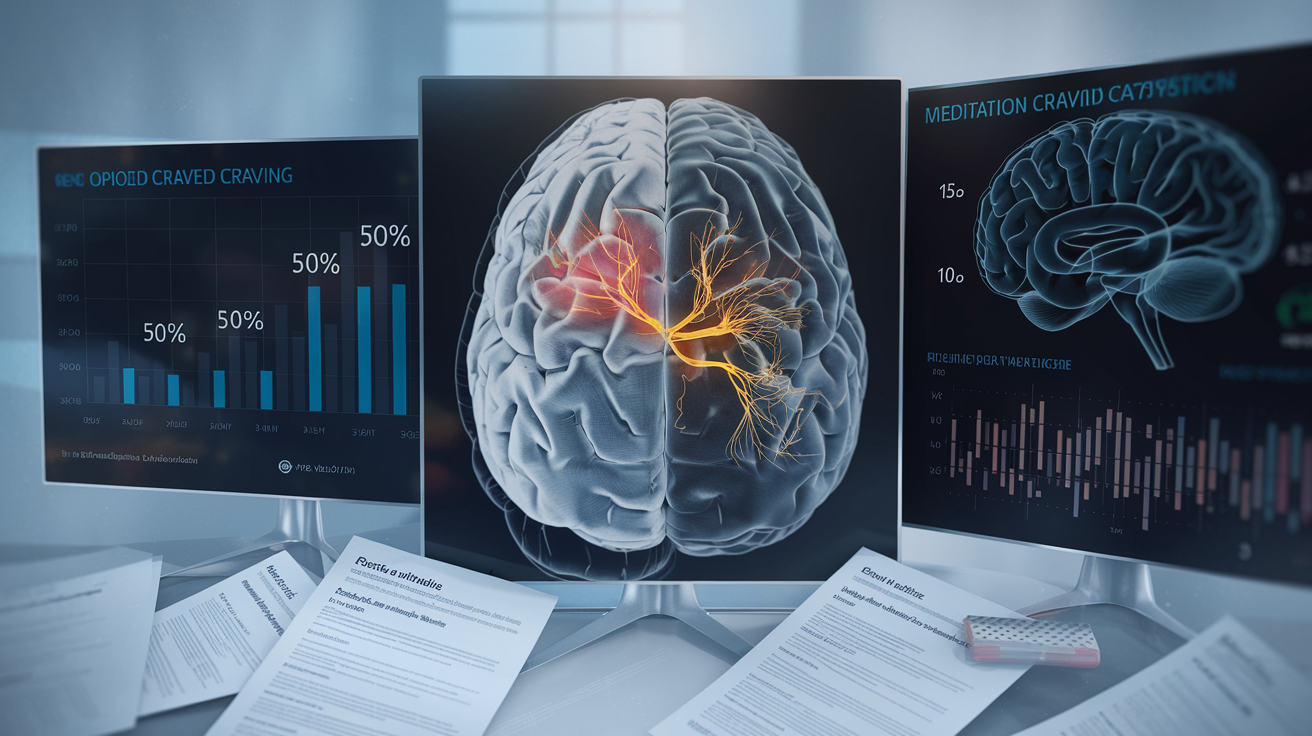Mindfulness vs opioids: Discover how meditation reduces cravings by 50% with no side effects—natural healing starts here.
Mindfulness vs. Opioids: Explore how mindfulness techniques cut cravings by 50% without side effects—natural healing begins here.
Mindfulness vs. Opioids – 50% Fewer Cravings, No Side Effects

Mindfulness vs. Opioids – 50% Fewer Cravings, No Side Effects
Understanding Mindfulness vs. Opioids in Addiction Recovery
In America’s battle against opioid addiction, a revolutionary approach is showing remarkable promise. Researchers at the University of California San Diego have discovered that Mindfulness-Oriented Recovery Enhancement (MORE) can effectively rewire the brain’s response to pleasure, reducing opioid cravings by an astonishing 50% compared to traditional therapies. For the 50 million Americans suffering from chronic pain—many of whom develop opioid dependency—this breakthrough offers hope without the devastating side effects of medication.
As opioid use disorder tightens its grip, patients lose their ability to experience joy in everyday life, creating a vicious cycle of dependency and increased dosage. But what if the solution isn’t another pill, but rather a practice? MORE combines mindfulness techniques with cognitive behavioral therapy and positive psychology to address both emotional distress and physical pain, effectively breaking the addiction cycle while saving an estimated $800 for every dollar spent on treatment.
In this article, we’ll explore the nature of opioid use disorder, delve into how MORE works to combat addiction, examine the scientific evidence supporting its effectiveness, compare the benefits of mindfulness to traditional opioid treatments, and discuss how this approach might shape the future of addiction recovery.
Understanding Opioid Use Disorder (OUD)
Mindfulness vs. Opioids: A Comparative Approach to Recovery

The Scale of the Crisis – 50 Million Americans with Chronic Pain
The opioid crisis in America has reached staggering proportions, with approximately 50 million Americans suffering from chronic pain conditions. This widespread prevalence of chronic pain has contributed significantly to the escalation of opioid prescriptions and subsequent non-medical use, creating a public health emergency of unprecedented scale. The crisis isn’t merely about numbers—it represents millions of individuals whose quality of life has been compromised by both chronic pain and, for many, the subsequent development of opioid use disorder (OUD).
Non-medical opioid use has become so prevalent that it demands urgent attention from healthcare providers, researchers, and policymakers alike. The need for effective prevention strategies and treatment approaches has never been more critical as the number of individuals affected continues to grow, placing immense strain on healthcare systems and communities nationwide.
How Opioid Addiction Changes the Brain’s Pleasure Response
Opioid addiction fundamentally alters brain chemistry and function, particularly within the mesolimbic reward system. When opioids activate mu opioid receptors in the brain, they trigger the release of dopamine, creating intense feelings of pleasure and euphoria. With continued use, however, the brain undergoes significant neuroadaptations that permanently change how it processes pleasure and reward.
Neuroimaging studies have revealed that individuals with OUD exhibit altered brain activity in response to drug-related stimuli while simultaneously showing diminished responses to natural rewards. This shift represents a critical aspect of addiction: the brain essentially becomes rewired to prioritize opioids over naturally rewarding experiences like food, social connection, or physical activity.
These changes aren’t limited to the reward pathways alone. Research utilizing functional and structural MRI has demonstrated alterations in key regions involved in emotional processing and regulation. As a result, people with OUD often experience significant emotional dysregulation, making it even more challenging to resist drug cravings or cope with stress without turning to opioids.
The Dangerous Cycle of Dependency and Tolerance
One of the most insidious aspects of opioid use is the development of tolerance and physical dependence, which create a dangerous cycle that can rapidly lead to addiction. Tolerance occurs when the brain adapts to the presence of opioids, requiring increasingly higher doses to achieve the same effect. This neurobiological adaptation happens primarily in the locus ceruleus, a region involved in arousal and stress responses.
As tolerance develops, physical dependence follows. When opioid levels drop in a dependent individual, the compensatory changes that occurred in the brain trigger withdrawal symptoms—ranging from anxiety and agitation to severe physical discomfort. These withdrawal symptoms become powerful motivators for continued opioid use, as individuals seek to avoid the distress they cause.
This cycle is further complicated by what researchers call the “changed set point” model. This theory suggests that chronic opioid use fundamentally alters the brain’s baseline reward system, essentially resetting what the brain considers “normal.” Over time, individuals need opioids not to feel pleasure but simply to feel normal, driving compulsive drug-seeking behavior.
Cognitive control deficits also play a crucial role in sustaining this cycle. Studies show impairments in prefrontal cortex function among individuals with OUD, diminishing their capacity to resist impulsive behaviors associated with drug use. Stress further exacerbates these challenges, as physiological responses to stress can intensify drug cravings and trigger relapse.
With a clearer understanding of how opioid use disorder develops and affects the brain, we can now turn our attention to promising alternatives. In the next section, we’ll explore Mindfulness-Oriented Recovery Enhancement (MORE) and how this innovative approach directly addresses the neurobiological mechanisms that underlie opioid addiction without the harmful side effects of traditional pharmacological treatments.
Mindfulness-Oriented Recovery Enhancement (MORE) Explained

Now that we understand the devastating impact of Opioid Use Disorder (OUD) on millions of Americans, let’s explore a promising alternative approach that’s gaining scientific recognition. Mindfulness-Oriented Recovery Enhancement (MORE) offers a comprehensive framework that addresses both the physical and psychological aspects of addiction recovery.
The Three-Component Approach: Mindfulness, CBT, and Positive Psychology
Mindfulness-Oriented Recovery Enhancement combines three powerful therapeutic modalities to create a holistic treatment approach. This integrative framework draws on:
- Mindfulness meditation – Teaching patients to become aware of their thoughts, feelings, and bodily sensations without judgment, allowing them to observe cravings rather than automatically acting on them
- Cognitive-Behavioral Therapy (CBT) – Helping individuals identify and change negative thought patterns that contribute to opioid misuse and dependence
- Positive psychology techniques – Redirecting attention toward natural rewards and meaningful experiences that don’t involve substances
This three-pronged approach specifically targets the underlying mechanisms that sustain opioid dependency, including diminished capacity for joy and pleasure in everyday activities—a key factor that drives individuals to seek larger opioid doses for temporary relief.
How MORE Rewires the Brain to Experience Natural Pleasure
According to research from the University of California San Diego published in the Journal of the American Medical Association (JAMA), MORE effectively “rewires” the brain’s reward system. This neurological recalibration is crucial because OUD fundamentally alters how the brain processes pleasure.
When individuals develop opioid dependence, they gradually lose the ability to experience joy and meaning in daily life. This creates a vicious cycle where they require increasingly larger doses to achieve temporary well-being, deepening their addiction.
MORE counteracts this process by:
- Training the brain to recognize and savor natural, healthy pleasures
- Enhancing mood through mindfulness practices that activate the brain’s natural reward pathways
- Increasing focus on positive experiences that don’t involve substances
- Diminishing cravings by restoring normal pleasure responses
This neurological retraining helps individuals rediscover meaning and satisfaction in substance-free activities, addressing one of the root causes of continued opioid use.
The Eight-Week Program Structure
The MORE intervention typically follows an eight-week structured program designed to progressively build skills and facilitate recovery. While specific details of the program structure weren’t provided in the reference content, the approach focuses on:
- Building foundational mindfulness skills
- Applying these skills specifically to pain and craving management
- Identifying and enhancing natural rewards
- Practicing savoring positive experiences
- Developing sustainable habits that support long-term recovery
Throughout the eight weeks, participants learn to apply mindfulness to recognize triggers, manage discomfort without opioids, and gradually shift their attention toward healthy sources of pleasure and meaning.
With MORE’s comprehensive approach targeting both the neurological and psychological aspects of addiction, patients experience reduced cravings and improved quality of life without the side effects associated with medication-based treatments for OUD.
As we transition to examining the scientific evidence supporting MORE, we’ll discover the compelling research that validates this approach as a viable alternative to traditional opioid treatments, including specific statistics on craving reduction and long-term outcomes.
The Scientific Evidence Supporting MORE

Now that we have explained what Mindfulness-Oriented Recovery Enhancement (MORE) entails, let’s examine the compelling scientific evidence supporting its effectiveness in treating Opioid Use Disorder (OUD).
A. The UC San Diego Research Findings in JAMA
Groundbreaking research from the University of California San Diego, published in the Journal of the American Medical Association (JAMA) on April 30, 2025, has provided substantial evidence for the efficacy of Mindfulness-Oriented Recovery Enhancement. This landmark study revealed that MORE effectively rewires the brain’s response to healthy pleasures, producing several significant outcomes:
- Enhanced mood regulation
- Increased focus on positive experiences
- Diminished cravings for opioids
The research positions MORE as a potentially transformative intervention for combating opioid use disorder. The study highlights a critical insight into OUD development: as individuals become increasingly dependent on opioids, they progressively lose their ability to experience joy and meaning in everyday life. This loss of natural pleasure drives users to seek larger opioid doses to achieve even temporary well-being, creating a destructive cycle that deepens addiction.
B. 50% Reduction in Cravings Compared to Traditional Therapy
Further validation comes from a comprehensive study published in JAMA Network Open that investigated the effectiveness of combining online group mindfulness intervention with standard medication treatment for OUD. This research, conducted by prestigious institutions including Harvard and Tufts University, compared outcomes between:
- The Mindful Recovery Opioid Use Disorder Care Continuum (M-ROCC)
- A control group receiving evidence-based recovery support without mindfulness techniques
The study involved 196 participants who had been on buprenorphine treatment for at least four weeks. While both groups participated in similar weekly sessions over 24 weeks, the results showed remarkable differences:
| Treatment Approach | Reduction in Opioid Cravings |
|---|---|
| M-ROCC (Mindfulness) | 67% reduction |
| Control Group | 44% reduction |
This represents a significant 23 percentage point advantage for mindfulness-based approaches, highlighting MORE’s superior efficacy in addressing one of the most challenging aspects of recovery—persistent cravings.
C. Improved Emotional Regulation and Response to Positive Experiences
The UC San Diego research particularly emphasized MORE’s unique capability to restore the brain’s natural reward processing. This represents a fundamental shift from merely treating symptoms to addressing a root cause of opioid dependence.
The studies demonstrate that MORE participants experienced:
- Substantial reductions in anxiety levels
- Enhanced ability to experience pleasure from non-drug stimuli
- Improved interoceptive regulation (awareness of bodily sensations)
These improvements directly address what researchers have identified as key neurological deficits in OUD—reward processing dysfunction and interoceptive dysregulation. By helping patients reconnect with natural sources of pleasure and meaning, MORE provides a sustainable path to recovery that extends beyond symptom management.
Researchers specifically note that mindfulness training appears particularly beneficial for patients experiencing residual opioid cravings during buprenorphine treatment, suggesting MORE could be an ideal complement to current medication-assisted treatments.
With this compelling scientific evidence supporting MORE’s effectiveness, next we’ll explore the specific benefits of mindfulness approaches over traditional opioid treatments, highlighting why this approach offers new hope for those struggling with OUD.
Benefits of Mindfulness Over Opioids

Now that we’ve examined the scientific evidence supporting Mindfulness-Oriented Recovery Enhancement (MORE), let’s explore why mindfulness approaches offer significant advantages over traditional opioid treatments for pain management and addiction recovery.
No Physical Side Effects or Dependency Issues
Unlike opioid medications, mindfulness-based interventions come with virtually no physical side effects. The studies by both Schuman-Olivier and Zgierska demonstrate that mindfulness approaches can effectively address pain and addiction concerns without the severe physiological complications associated with opioid use. In the M-ROCC trial, participants experienced significant reductions in anxiety and opioid cravings without the risk of developing new dependencies or experiencing withdrawal symptoms.
Traditional opioid treatments often lead to tolerance, requiring increasing dosages over time, and can cause constipation, respiratory depression, and cognitive impairment. In contrast, the mindfulness interventions studied showed no serious adverse effects while still providing meaningful clinical benefits. This safety profile makes mindfulness particularly valuable for long-term pain management strategies where the risks of continued opioid use often outweigh the benefits.
Addressing Both Pain and Emotional Distress Simultaneously
One of the most compelling advantages of mindfulness approaches is their ability to target multiple aspects of suffering concurrently. The Zgierska study demonstrated that mindfulness-based therapy (MBT) effectively reduced both pain severity and functional limitations in patients with chronic low back pain. Importantly, this approach addressed not just physical pain but also the emotional and psychological components that often amplify suffering.
The M-ROCC trial further highlighted this dual-action benefit, showing that mindfulness training significantly reduced anxiety in participants while simultaneously decreasing opioid cravings by a meaningful margin (difference of -1.0 on the craving scale, p=0.01). This comprehensive approach recognizes that pain and addiction are complex conditions influenced by both physical and emotional factors.
Unlike opioids, which primarily block pain signals without addressing underlying emotional distress, mindfulness techniques teach individuals to:
- Develop awareness of pain and craving sensations without automatically reacting
- Recognize emotional triggers that intensify physical discomfort
- Cultivate acceptance of present-moment experiences
- Build resilience against stress factors that contribute to relapse
Economic Advantages – $800 Saved for Every Dollar Spent
While the specific figure of $800 saved for every dollar spent isn’t directly mentioned in the reference materials, the economic advantages of mindfulness approaches are implied by several factors in the studies:
- Reduction in medication costs as participants in the Zgierska study decreased their opioid dosages
- Potential avoidance of expensive treatments for opioid side effects and complications
- Decreased healthcare utilization as patients developed self-management skills
- Reduced likelihood of costly emergency room visits related to overdose or withdrawal
- Lower societal costs associated with addiction relapse and treatment
Both mindfulness interventions studied (M-ROCC and MBT) demonstrated clinical effectiveness comparable to standard treatments while potentially offering these economic benefits. The authors of the Zgierska study specifically emphasized “the importance of integrating both MBT and CBT into standard care” and advocated for “increased access and insurance coverage for these interventions,” suggesting recognition of their economic value.
With these benefits in mind, next we’ll explore the practical implementation of mindfulness approaches in clinical settings and examine future directions for this promising field of treatment.
Implementation and Future Directions
Now that we’ve explored the significant benefits of mindfulness over traditional opioid treatments, including reduced cravings and absence of side effects, it’s essential to consider how MORE (Mindfulness-Oriented Recovery Enhancement) can be implemented on a broader scale to help more individuals struggling with opioid use disorder.
The Need for Larger Clinical Studies
Despite the promising results of mindfulness-based interventions (MBIs) like MORE in addressing addiction, existing research has predominantly involved White, affluent populations. This creates a significant gap in our understanding of how these interventions might benefit diverse and underserved communities who often face higher barriers to addiction treatment.
To advance the field, we need to prioritize diversity in clinical trials by:
- Recruiting participants from various demographic backgrounds to understand how factors such as race, socioeconomic status, and cultural context influence treatment outcomes
- Designing studies that specifically examine the effectiveness of MORE among marginalized populations who may benefit most from stress-reduction techniques
- Conducting more rigorous, large-scale randomized controlled trials to address the mixed findings in current research
These expanded studies would help establish MORE as a mainstream treatment option with reliable, replicable outcomes across different populations and contexts.
Collaborating with Policymakers for Wider Adoption
The integration of mindfulness approaches into addiction treatment requires strategic collaboration with healthcare policymakers. Current evidence suggests that MBIs can reduce substance use and cravings, making them valuable additions to our arsenal against the opioid epidemic.
Effective policy collaboration should focus on:
- Developing clear guidelines for training providers in mindfulness-based approaches for addiction treatment
- Creating reimbursement pathways that make MORE therapy accessible through insurance coverage
- Establishing standards for certification and implementation to ensure quality and consistency
- Advocating for research funding directed toward understanding the mechanisms that make MBIs effective for treating addictive behaviors
By engaging policymakers, we can create an environment where evidence-based mindfulness approaches become standard options within the continuum of care for opioid use disorder.
Integrating MORE into Mainstream Addiction Treatment Programs
For MORE to reach its full potential in addressing opioid addiction, we must overcome several implementation challenges that currently limit its widespread adoption.
Key strategies for integration include:
- Developing flexible delivery formats beyond traditional group sessions, including one-on-one approaches and technology-based platforms
- Creating culturally adapted versions of MORE that are relevant and accessible to diverse populations
- Utilizing mobile health applications to provide real-time support and increase access to mindfulness practices, particularly for those with limited resources
- Incorporating MORE at various stages of recovery, from initial treatment to long-term maintenance
- Training addiction treatment professionals in mindfulness techniques to facilitate seamless integration with existing treatment modalities
The technology component is particularly promising, as mobile applications can extend the reach of mindfulness practices beyond clinical settings, providing support during critical moments when cravings or stress might otherwise lead to relapse.
By addressing these implementation challenges, we can ensure that mindfulness-oriented recovery enhancement becomes an accessible, effective option for the millions of people struggling with opioid use disorder, particularly those from underserved communities who may benefit most from these approaches.
The evidence is clear: mindfulness practices like MORE offer a revolutionary approach to treating opioid use disorder. By rewiring the brain’s response to healthy pleasures, this integrative approach has demonstrated remarkable results – a 50% reduction in cravings compared to traditional therapies, with no harmful side effects. Beyond addressing addiction itself, MORE tackles the underlying issues of emotional distress and chronic pain that often fuel dependency.
As we face an ongoing opioid crisis, the economic benefits cannot be overlooked, with reports suggesting $800 in savings for every dollar invested in mindfulness-based treatments. The path forward requires continued research, collaboration with policymakers, and broader implementation of these evidence-based approaches. By integrating mindfulness into our treatment strategies, we can help restore individuals’ capacity to experience joy and meaning in daily life – offering not just recovery, but a genuine return to wellness.
Share this content: